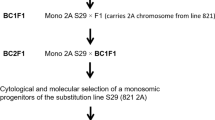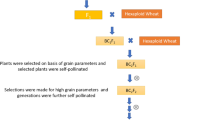Abstract
Diverse technological purposes of bread wheat grain requires a broadening the genetic base of selection for quality traits. Introgressions potentially may affect technological properties of grain and flour and add to a genetic variability of the trait. The aim of this work was to investigate the influence of introgressions from exotic tetraploid wheat Triticum timopheevii and wild cereal species, Aegilops speltoides and Aegilops markgrafii into bread wheat on grain quality. The introgression from T. timopheevii including the microsatellite marker Xgwm636 into 2AS chromosome of cv. Saratovskaya 29 resulted in a significant increase of gluten content in grain. The effect was confirmed by re-introducing the recombinant chromosome again into the same genetic background. The analogous effect was observed in the line of winter cultivar Alcedo with the similar alien fragment in 2AS chromosome inherited from Ae. markgrafii. Introgression of 5S chromosome of Aegilops speltoides carrying the gene Ha-Sp for grain softness into hard-grain bread wheat cultivars resulted in obtaining the genotypes with soft grain texture. Combining two dominant genes for grain softness Ha and Ha-Sp in one genotype allowed us to obtain the plants with grain having the new milling properties – very low vitreousness (about 30 %) and small particle size (about 10 μm).
You have full access to this open access chapter, Download conference paper PDF
Similar content being viewed by others
Keywords
Diverse technological purposes of bread wheat grain require a broadening the genetic base of selection for quality traits. The wild cereal species are widely used for improvement of bread wheat in respect to resistance to fungus diseases through a wide hybridization. The resulted genotypes often carry the alien genetic material with known chromosomal location and rearrangements indicated with molecular markers. Such introgressions potentially may affect technological properties of grain and flour and add to a genetic variability of the trait. Alien cereal species often have a high protein and gluten in grain but, unfortunately, the quality of their gluten is low. Often it has dark unattractive color and sticky in a consistence. For these negative features introgression lines are not considered as possible sources of genetic variability for quality traits. At the same time, the limited introgressions may positively effect on technological properties of grain and flour. It was demonstrated with discovery and investigation of Gpc-B1 gene for high protein content in grain introgressed from Triticum dicoccoides into durum and bread wheat (Carter et al. 2012). The aim of this work was to investigate the influence of introgressions from exotic tetraploid wheat Triticum timopheevii and wild cereal species, Aegilops speltoides and Aegilops markgrafii into bread wheat on grain quality.
The collection of lines with introgressions from T. timopheevii were obtained by crossing and one backcrossing with several spring bread wheat cultivars followed by multiply selection on resistance to fungi diseases (Budashkina 1988). Two lines, 821 and 842, were obtained on the genetic background of cv. Saratovskaya 29 (S29). As was determined using microsatellite markers they carry very similar fragments of introgressions (Leonova et al. 2001). The line 821 carries an entire short arm introgression in 2A chromosome while the line 842 carries a shorter fragment which does not include the distal markers Xgwm636 and Xgwm296. Gluten content in grain was studied in the lines and their parents using a standard method of washing in tap water (Anonymous 1988). Compare of the lines with the parents showed that donor had the highest gluten content, about 57 %, while the recipient cv. S29 had a significantly lower meaning, 34.5 % (Fig. 32.1a). From the two lines, the line 821 had high gluten content (45 %) while the line 842 had the gluten content comparable with the recipient S29. It was supposed that the gene responsible for high gluten content in grain introgressed from T. timopheevii is situated in a distal part of 2AS chromosome in the region of microsatellite marker Xgwm636.
Wet gluten content (GC) in grain of bread wheat lines with introgressions from wild cereals: (a) introgression lines 842 (low GC) and 821 (high GC), cv. S29 (recipient), T. timopheevii (donor); (b) cv. S29 (recipient), introgression line 821 (high GC), substitution line S29 (821 2A); (c) introgression line M483/98, cv. Alcedo (recipient), Ae. markgrafii (donor)
To verify this, the recombinant 2A chromosome was introduced from the line 821 again in the genetic background of S29. The line was crossed and backcrossed to the monosomic line for 2A chromosome of the recipient and the disomic population was developed. Again gluten content in grain was studied in the new line. It was found (Fig. 32.1b) that the gluten content was significantly higher in the line than in the recipient and was comparable to 821 line.
Introgression with the similar position on 2AS chromosome was detected in the line M483/98 obtained by crossing of winter cultivar Alcedo and Aegilops markgrafii (Weidner 2004). The introgression includes the region of Xgwm636 and limited by Xgwm296 marker (Iqba et al. 2007). Again the wild cereal had the highest gluten content in grain, more than 40 % (Fig. 32.1c). The mean of the trait in the line 483/98 did not reach the donor meaning but it was on 10 % higher than in the parental cultivar Alcedo. The difference was statistically significant. Now this chromosome is being introduced from introgression line into S29 background in order to compare its effect with introgression from T. timopheevii.
Earlier, the quantitative trait locus QPro.inra-2A for a high protein content in grain was positioned in the region of Xgwm636 using the mapping population of bread wheat Renan × Recital (Groos et al. 2003). The donor of high meaning of the trait was cv. Renan. A close correlation of protein content in grain with gluten content and the similarity of the marker positions associated with manifestation of the traits in different genetic material suggest the presence of the responsible locus on the short arm of 2A chromosome.
Milling parameters are determined by endosperm texture of wheat grain. Vitreous grains give a hard-grain flour with big particles and floury grain gives soft flour with small particles. Different kinds of flour are used for different technological purposes (Peña 2002). Today all the variability is provided by mutations in one locus Ha on 5DS chromosome (Morris 2002). Milling parameters show a quantitative variability but usually cultivars retain the certain characteristics of the trait.
The effect of introgression of 5S chromosome from Ae. speltoides on expression of milling parameters was studied in the work. Vitreousness was determined on cut halves of grains visually; flour particle size was determines instrumentally using PSH-4 device (Anonymous 1988). The line 84/98w from ‘Arsenal’ collection (Lapochkina et al. 2003) obtained from a wide cross of Ae. speltoides with spring wheat cultivar ‘Rodina’ was used. Winter growth habit and presence of awns indicated the introgression into 5A chromosome. Additionally, the line was characterized with a significantly lower vitreousness of endosperm and smaller flour particle size comparing to the initial hard-grained cultivar (Table 32.1).
In order to prove that just this introgression is responsible for changes in milling parameters this chromosome was introduced into two hard-grain cultivars S29 and Diamant 2 using monosomic lines for 5A chromosomes. It was found that this chromosome significantly decreases vitreousness and particle size to the meanings compared with the meaning of the introgression line (Table 32.2). The introgressed gene was designated with a temporarily gene symbol Ha-Sp (Pshenichnikova et al. 2010).
Crossing of introgression line with cultivar Chinese Spring – carrier of the dominant allele of Ha gene in 5DS chromosome resulted in emergence of wide variability in milling parameters relatively parental forms (Fig. 32.2). Among them the plants were found carrying two dominant genes for grain softness with new milling properties – very low vitreousness (0–30 %) and small particle size (11–12 μm). These plants have become the progenitors of F6-F7 lines which retain these properties. Their flour may be used for special technological purposes.
References
Anonymous (1988) Methods of state variety testing of crops. Gosagroprom Publisher, Moscow
Budashkina E (1988) Cytogenetic study of introgressive disease-resistant common wheat lines. Tag Ber Acad Landwirtsch Wiss DDR 206:209–212
Carter A, Santra DK, Kidwell KK (2012) Assessment of the effects of the Gpc-B1 allele on senescence rate, grain protein concentration and mineral content in hard red spring wheat (Triticum aestivum L.) from the pacific northwest region of the USA. Plant Breed 131:62–68
Groos C, Robert N, Brevas E, Charmen G (2003) Genetic analysis of grain protein-content, grain yield and thousand-kernel weight in bread wheat. Theor Appl Genet 106:1032–1040
Iqba N, Eticha F, Khlestkina EK et al (2007) The use of simple sequence repeat (SSR) markers to identify and map alien segments carrying genes for effective resistance to leaf rust in bread wheat. Plant Genet Res 5:100–103
Lapochkina IF, Iordanskaya IV, Yatchevskaya GL, et al (2003) Identification of alien genetic material and genes of resistance to leaf rust in wheat (Triticum aestivum L.) stocks. In: Pogna NE, Romanó M, Pogna E, Galterio G (eds) Proceedings of the 10th international wheat genet symposium. Istituto Sperimentale per la Cerealicoltura, Roma, pp 1190–1192
Leonova IN, Kalinina NP, Budashkina EB, et al (2001) Comparative molecular and genetic analysis of Triticum aestivum × Triticum timopheevii hybrid lines resistant to leaf rust. EWAC newsletter, 2001. In: Proceedings of the 11th EWAC conference, Novosibirsk, pp 140–143
Morris CF (2002) Puroindolines: the molecular basis of wheat grain hardness. Plant Mol Biol 48: 633–647
Peña RL (2002) Wheat for bread and other foods. In: Curtis BC, Rajaram S, Gómez Macpherson H (eds) Bread wheat. Improvement and production. FAO plant production and protection series. No. 30, Food and agriculture organization of the United Nations, Rome
Pshenichnikova TA, Simonov AV, Ermakova MF et al (2010) The effects on endosperm structure of the grain of an introgression from Aegilops speltoides Tausch into chromosome 5А of bread wheat. Euphytica 175:315–322
Weidner A (2004) Selection and characterization of wheat – Ae. markgrafii introgression lines resistant to leaf rust. Dissertation, Martin-Luther-University Halle Wittenberg, Halle (Saale)
Author information
Authors and Affiliations
Corresponding author
Editor information
Editors and Affiliations
Rights and permissions
Open Access This chapter is distributed under the terms of the Creative Commons Attribution Noncommercial License, which permits any noncommercial use, distribution, and reproduction in any medium, provided the original author(s) and source are credited.
Copyright information
© 2015 The Author(s)
About this paper
Cite this paper
Pshenichnikova, T.A., Simonov, A.V., Shchukina, L.V., Morozova, E.V., Chistyakova, A.K., Börner, A. (2015). Enlargement of the Genetic Diversity for Grain Quality in Bread Wheat Through Alien Introgression. In: Ogihara, Y., Takumi, S., Handa, H. (eds) Advances in Wheat Genetics: From Genome to Field. Springer, Tokyo. https://doi.org/10.1007/978-4-431-55675-6_32
Download citation
DOI: https://doi.org/10.1007/978-4-431-55675-6_32
Publisher Name: Springer, Tokyo
Print ISBN: 978-4-431-55674-9
Online ISBN: 978-4-431-55675-6
eBook Packages: Biomedical and Life SciencesBiomedical and Life Sciences (R0)






